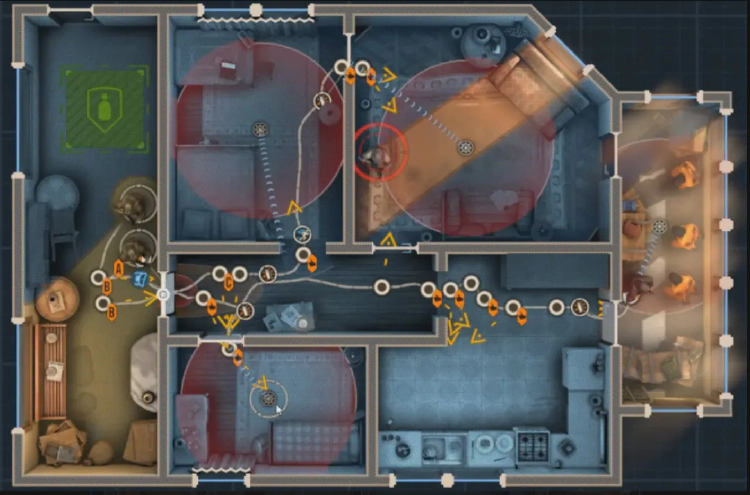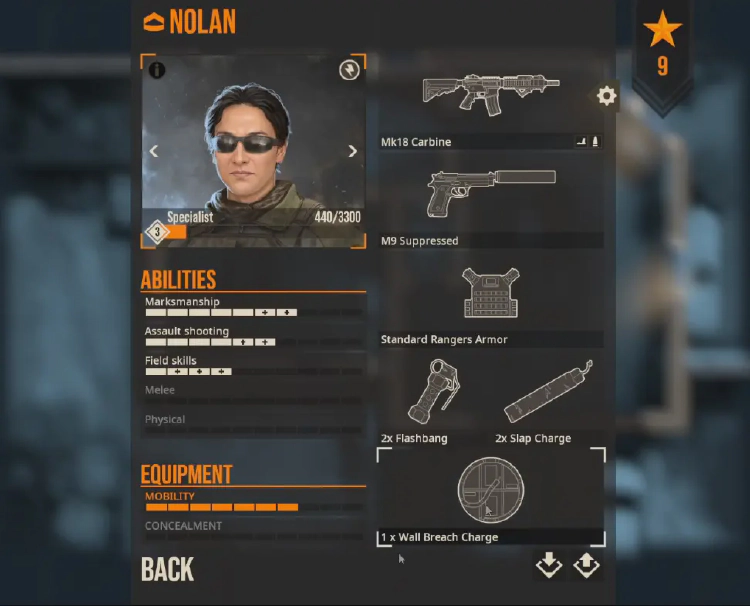
Door Kickers 2 Analysis and Improvement Scenarios
Author:Director of Special Operations Ziming Wang
Contents
1. Highlights Design
1.1 Game Mechanics
Door Kickers 2 gave me an experience that was like commanding the cadres in Rainbow Six from a tactical board and breaking into a Chicago mansion to rescue a hostage. I needed to observe the terrain and enemy distribution through the level to find the optimal solution to complete the mission. To be able to minimize casualties, I had to adjust the equipment and carry the props of each person in the field based on their abilities before the battle and make the most of their strengths during the battle.
During the game, players need to give commands to each character. And always observe the battle, press pause when necessary, and adjust the character’s commands to deal with unexpected situations.

1.2 Roles
1.2.1 Regular Roles
Each character has three attribute values: marksmanship, assault shooting, and field skills. Carrying a primary weapon, a secondary weapon, body armor, two props, and a tactical prop is also allowed. The player can adjust the choice of weapons and props for the character in the play to the scenario of the level, based on the attribute values of the chosen character.

1.2.2 Lurking Role (CIA)
CIA characters can infiltrate the enemy at the expense of body armor and primary weapons to see information about enemy stations and targets.
CIA characters can be equipped with silenced pistols to take some hard-to-solve enemy spots by surprise.
CIA characters can also provide constant vision and will not reveal their identity as long as they are not present in the engagement area or spotted by the enemy with their guns.

2. Improvement Scenarios
2.1 Melee System (coming soon)
Currently, the game only offers two types of kills, gun kills and prop kills, however, the addition of a melee kill mechanic could significantly increase the gameplay strategy for sneaky characters.
Lurking characters may carry either a knife or a cutthroat rope, where.
- Knife attacks are sure to hit and can immediately kill back facing enemies, this engagement area permanently becomes a suspect area (yellow rank) with a smaller range. If the enemy is attacked head-on, a one-hit kill is possible depending on the character’s value. If a kill is not possible, the lurking character is immediately exposed (red level), and after killing that enemy and any other enemies that observe the lurking character, the lurking character’s lurking level slowly drops to safe (blue level). And the engagement area becomes permanently exposed (red rank) with a larger range.
- Cutthroat rope is sure to hit when attacking from the back, and can whisper-drag a single enemy for a distance; the enemy will die after a period of dragging, the movement speed of the lurking character is significantly reduced during the dragging process, and the route during the dragging process temporarily becomes an area of suspicion (yellow rank), which gradually changes to a safe area (blue rank) after some time. Unable to initiate an attack from the front, cutthroat rope makes a sound during the drag, making it a high-risk, high-reward melee weapon.
2.2 AI Behavior
The current AI behavior in the game is not good: as terrorists, their behavior sometimes seems too reckless, and sometimes seems very solid. As a team of terrorists capable of planning a terrorist operation, or taking hostages, their behavior should be organized and disciplined, so a more diverse AI behavior should be designed to enhance the game’s strategy and provide a realistic counter-terrorism experience.
- Patrolling Enemy (already exists, can be optimized): normally patrols on a prescribed path and goes to check when he hears a sound. If he encounters an enemy, he enters combat; if no enemy is found after checking, he returns to patrol status but adds patrol points in the direction of the sound, and that patrol point stays longer.
- Scouting type enemy: the enemy near the door, or window, under normal circumstances will not move position, only in a fixed position occasionally, towards the outside to observe the situation. When he sees an enemy, he will decide his behavior according to the enemy’s position: when the enemy is very close to him, he will immediately enter the battle state and will not leave his position; when the enemy is very far from him, he will immediately move and change his position. In both cases, the scouting type enemy will make a sound to alert surrounding teammates to go on alert. Teammates on alert will continue to aim in the direction of the scouting type teammate’s warning for some time.
- Output enemies (already exists, can be optimized): output enemies refer to the machine gunners behind the sandbags, they will not change their positions because of their teammates' positions, and will remain in a position to output until they die. When hit by a flashbang, or if their view is obscured by smoke grenades, they will fire recklessly in the direction of the output enemy’s original position if they have spotted the enemy before being hit & obscuring their view (reckless fire with a low hit rate)
- Defensive enemies (existing, can be optimized): defensive enemies are usually located behind cover, and unlike output enemies, will look for opportunities to change their position once a teammate around them has been killed (preferentially moving behind a new cover), and will not shoot recklessly when hit by flashbangs, or when their view is obscured by smoke grenades, but will only shoot at observed enemies.
- Commanding enemy: You can refer to Sniper Elite 4’s officer AI design. The commanding enemy will issue commands to his surrounding companions to change the AI’s behavior: if there is a sound, the commanding enemy next to him can command a nearby defensive enemy to change his AI behavior to temporarily change the way the patrolling enemy behaves. Once the commanding enemy dies, the enemy who was commanded to change his AI behavior will automatically change back to the original set behavior.
- Suicide Terrorist (existing, can be optimized): instead of recklessly running through the streets looking for enemies to die with, suicide terrorists should calmly, and only start chasing enemies when they see them at a certain distance. Instead of blowing themselves up when hit by a flashbang, or when their vision is obscured by a smoke grenade, suicide terrorists will stay put and keep watching the direction of pursuit.
- Hostage-killing enemies (already exists, can be optimized): Hostage-killing enemies should have a pressure value, which is determined by the intensity of the engagement in the surrounding environment and whether the surrounding teammates survive. When the pressure value is too high, then they will kill the hostage early, otherwise, they will just approach the hostage and be ready to kill them at any time.
- Trap Enemies: trap enemies are like defensive enemies, but when engaged, their highest priority target for attack is not the enemy, but the traps (explosives, flasks, etc.) near the enemy, and will attack the enemy if there are no traps around them. If the trap is removed and the trapped enemy is unaware of it, the trap enemy’s primary target remains the trap (even if it has been removed), and will only turn to the enemy when the trapped enemy has failed to trigger the trap multiple times.





